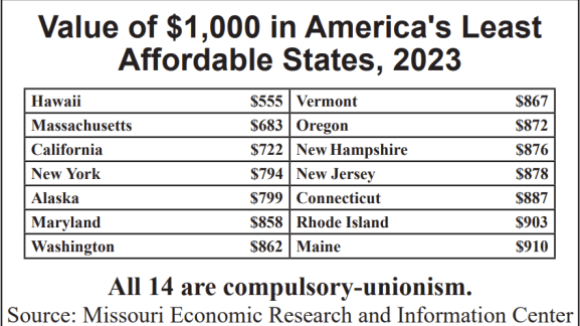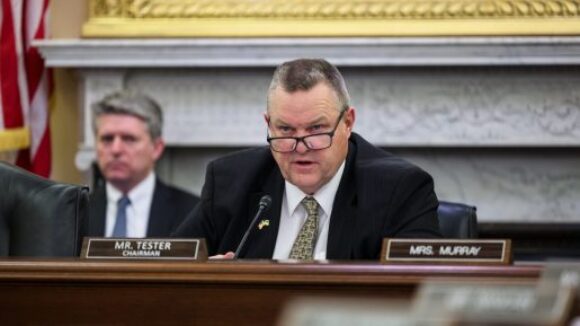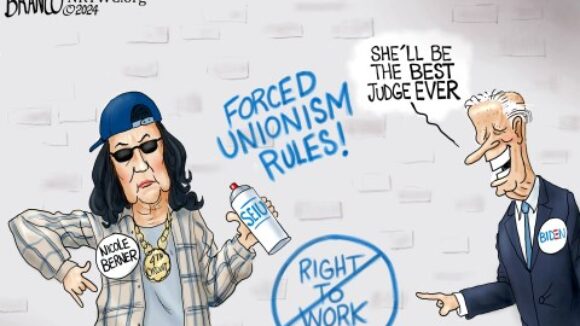Banning Compulsory Dues Curbs Cost of Living
On average, forced-unionism states are 23.2% more expensive to live in than Right to Work states. And decades of academic research show that compulsory unionism actually fosters a higher cost of living.
The Wall Street Journal weighs in on the Obama big labor contracting kickback scheme to hand government contracts to unionized companies:
There’s almost a direct correlation these days between the Obama Administration’s complaints about “special interests” and its own fealty to such interests. Consider its latest decree that federal contractors must be union shops.
The federal rule, which went live yesterday, implements an executive order President Obama signed within weeks of taking office. It encourages federal agencies to require “project labor agreements” for all construction projects larger than $25 million. This means that only contractors that agree to union representation are eligible for work financed by the U.S. taxpayer.
Only 15% of the nation’s construction workers are unionized, so from now on the other 85% will have to forgo federal work for having exercised their right to not join a union. This is a raw display of political favoritism, and at the expense of an industry experiencing 27% unemployment. “This is nothing but a sop to the White House’s big donors,” says Brett McMahon, vice president at Miller & Long Concrete Construction, a nonunion contractor. “We’ve seen this so many times now, and how many times does it have the union label? Every time.”
It’s also a rotten deal for taxpayers. White House economist Jared Bernstein blogged that these agreements “significantly enhance the economy and efficiency of Federal Construction projects.” In fact, the carve-outs put an end to open, competitive federal bidding, which means higher project costs. They also mean taxpayers must finance the benefits and work rules of union members.
Mr. Bernstein could check all this with the Department of Veterans Affairs, which last year commissioned an independent study showing the Obama project labor agreements would likely raise the VA’s construction costs for hospitals by as much as 9% in three of five markets—Denver, New Orleans and Orlando. In two others, New York and San Francisco, the study predicted a mixture of small cost increases and small cost savings.
The study reported “strong evidence to suggest that the result of a PLA [project labor agreement] that dictates work rules, double benefits, team structure and activities on non-union type contractors will be that production costs will increase—given these union-related requirements.” It also rebutted a favorite liberal argument that such agreements lead to less labor strife, noting that there are “many examples for projects where there have been strikes but also no strikes—unrelated to whether or not a PLA is in place.”
The Veterans study mirrors academic work showing that project labor agreements raise the costs of construction by 10% to 20%. The Beacon Hill Institute at Boston’s Suffolk University in 2006 investigated the costs of building 126 Boston-area schools. It found project labor agreements raised winning bids for school construction projects by 12% and actual construction costs by 14%.
Boston’s Big Dig, Seattle’s Safeco field, Los Angeles’s Eastside Reservoir project, the San Francisco airport, Detroit’s Comerica Park—all were built under PLAs marked by embarrassing cost overruns. We’d list more, but newsprint is expensive.
The White House went out of its way to note that the Supreme Court has upheld such agreements in the past, suggesting it has a guilty conscience. In fact, the High Court has never ruled on the legality of these agreements under federal competitive bidding laws. Industry groups are now threatening legal action to defend the rights of workers who will be denied employment for the crime of not sporting Obama-Biden bumper stickers. It’s a fight worth having.

On average, forced-unionism states are 23.2% more expensive to live in than Right to Work states. And decades of academic research show that compulsory unionism actually fosters a higher cost of living.

Thanks to the Committee's election-year program, union-label candidates like Sen. Jon Tester (Mont.) are being given a choice: pledge to change course and support Right to Work going forward, or face the potential political consequences.

Biden judicial nominee Nicole Berner has a track record of mindlessly repeating union bosses’ anti-Right to Work diatribes and defending their schemes to profit at the expense of the disabled.